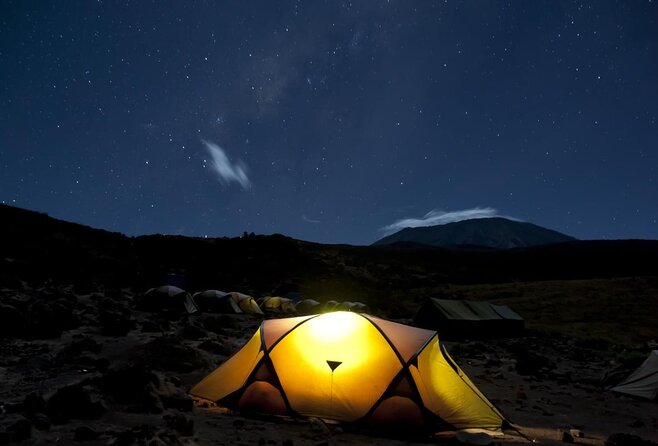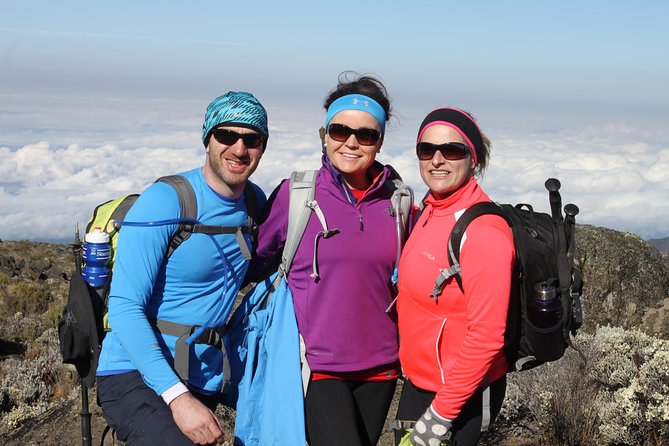The Kilimanjaro Lemosho Route is a popular seven-day trek that offers hikers a chance to experience the stunning natural beauty of the mountain. Starting from the western side, this route provides a quieter and more scenic ascent, allowing for gradual acclimatization as climbers traverse diverse landscapes. From lush rainforests to challenging rocky terrain, the Lemosho Route promises an unforgettable adventure. With well-placed camps and essential safety measures in place, this route is an excellent choice for those seeking a truly rewarding Kilimanjaro experience. But before embarking on this journey, there are a few crucial factors to consider.
Good To Know

- The Lemosho Route is a scenic, less crowded 7-day trek on Kilimanjaro’s western side, providing gradual acclimatization for hikers.
- The route traverses diverse landscapes, including rainforests and alpine desert, with well-placed camps to aid in altitude adjustment.
- Trekkers can enjoy the tranquility of less-crowded trails, crossing the Shira Plateau and ascending the challenging Barranco Wall.
- Shira Camp at 3,840 meters offers an opportunity for rest, hydration, and acclimatization hikes to higher elevations.
- The summit ascent to Uhuru Peak at 19,341 feet presents challenging conditions, but reaching the top rewards climbers with stunning views.
Embarking on the Lemosho Route
The Lemosho Route is a less crowded and more scenic path up Kilimanjaro. This seven-day trek begins on the western side of the mountain, offering hikers a chance to acclimatize gradually.
The route includes the beautiful Shira Plateau and the Barranco Wall, providing stunning views along the way. Trekkers will traverse diverse landscapes, from lush rainforests to the barren alpine desert near the summit.
While the Lemosho Route is considered physically demanding, the gradual ascent and well-placed camps help climbers adjust to the altitude.
With experienced guides, reliable equipment, and proper preparation, this route offers an excellent opportunity to reach the iconic Uhuru Peak.
You can also read our reviews of more tours and experiences in Moshi

Embarking on the Lemosho Route, trekkers will enjoy the tranquility of its less-crowded trails. This quieter approach allows for a more immersive, peaceful experience as you make your way through the diverse landscapes.
Some highlights include:
- Crossing the Shira Plateau, a vast and scenic high-altitude desert.
- Ascending the Barranco Wall, a challenging yet rewarding scramble with stunning views.
- Marveling at the volcanic landscapes and glaciers as you near the summit.
- Savoring the sense of accomplishment upon reaching Uhuru Peak, the highest point in Africa.
The Lemosho Route’s serene, gradual ascent provides the perfect setting for hikers to fully appreciate the grandeur of Kilimanjaro.
Acclimatizing at Shira Camp

After traversing the serene Lemosho trail, trekkers arrive at Shira Camp, a critical stop for acclimatization. At an elevation of 3,840 meters (12,600 feet), the camp offers stunning views of the Shira Plateau and the towering Kibo peak. Here, climbers have the opportunity to rest, hydrate, and allow their bodies to adapt to the increasing altitude. The following table provides an overview of the key activities and experiences at Shira Camp:
| Activity | Description |
|---|---|
| Acclimatization Hike | A short, guided hike to higher elevations to aid acclimatization. |
| Guided Exploration | Explore the unique Shira Plateau landscape with an experienced guide. |
| Rest and Relaxation | Ample time to rest, recharge, and prepare for the next leg of the journey. |
| Stunning Vistas | Take in the breathtaking views of the surrounding mountains and glaciers. |
Conquering the Barranco Wall
Scaling the imposing Barranco Wall is a pivotal challenge on the Kilimanjaro Lemosho Route. This 850-foot obstacle tests climbers’ stamina and determination, but the sense of accomplishment upon reaching the top is immensely rewarding.
The route involves:
- Scrambling up steep, rocky terrain using your hands and feet
- Navigating narrow ledges with sheer drops on either side
- Carefully managing your pace and energy levels
- Trusting your guide’s expertise to find the safest path
Overcoming the Barranco Wall is a highlight of the Kilimanjaro journey, showcasing the climbers’ grit and the mountain’s grandeur.
With proper preparation and a steadfast mindset, this challenge can be conquered, bringing trekkers one step closer to the summit.
Ascending to Uhuru Peak
The final push to the summit of Kilimanjaro’s Uhuru Peak is the culmination of the Lemosho Route journey. Trekkers ascend the steep Barranco Wall, then traverse the Karanga Valley before making the final ascent.
The path becomes more challenging as the air thins, but the guides are experienced in managing the group’s pace and monitoring for altitude sickness.
Reaching Uhuru Peak at 19,341 feet is an exhilarating moment, rewarding climbers with stunning views across the African landscape.
Celebrating this incredible achievement, trekkers then descend via the Mweka Route, their sense of accomplishment and pride unmatched.
Descending via Mweka Gate
Climbers descend the mountain via the Mweka Route after summiting Uhuru Peak. The Mweka Route is a popular descent path, known for its steep inclines and scenic views.
Some key points about the descent:
-
The descent typically takes 5-7 hours, depending on the group’s pace and fitness level.
-
Trekkers must check out at the Mweka Gate before continuing their journey.
-
Porters transport the group’s gear, allowing climbers to focus on safely navigating the descent.
-
Hikers are advised to stay hydrated, take breaks as needed, and exercise caution on the steep, rocky terrain.
-
The Mweka Route ultimately delivers climbers back to the Mweka Camp, where they can rest and celebrate their Kilimanjaro achievement.
Accommodations and Meals
Accommodations and meals on the Kilimanjaro Lemosho Route 7-day trek are carefully curated to ensure a comfortable and nourishing experience for climbers. Trekkers enjoy 2 nights in classic standard hotels before and after the climb, along with 2 nights in comfort hotels, all with full board service. During the trek itself, campers are provided with high-quality waterproof tents, sleeping mats, and other essential camping gear.
| Meal | Breakfast | Lunch | Dinner |
|---|---|---|---|
| Day 1 | ✓ | ✓ | ✓ |
| Day 2-6 | ✓ | ✓ | ✓ |
| Day 7 | ✓ | ✓ | – |
Purified drinking water and warm washing water are available daily, ensuring hydration and cleanliness throughout the expedition.
Safety and Preparation
Safety and preparedness are paramount for trekkers embarking on the Kilimanjaro Lemosho Route 7-day expedition. The tour operator ensures climbers’ well-being with essential safety equipment, including:
- Emergency oxygen tanks and a Gamow Bag (hyperbaric chamber) for altitude sickness management
- VHF handheld radios and a pulse oximeter to monitor vital signs
- A portable personal flash toilet for comfortable, hygienic facilities during the trek
Participants must be in moderate physical condition, as the route isn’t wheelchair-accessible and not recommended for those with back problems, pregnant travelers, or those with serious medical conditions.
Proper preparation, including acquiring a Tanzania visa, is crucial for a successful and safe journey to the summit of Mount Kilimanjaro.
Frequently Asked Questions
What Is the Difficulty Level of the Kilimanjaro Lemosho Route?
The Kilimanjaro Lemosho Route is considered moderately difficult, requiring a moderate level of physical fitness. It’s not recommended for those with serious medical conditions or mobility issues, but it’s suitable for most reasonably fit travelers.
Can I Bring Additional Personal Equipment on the Trek?
Yes, travelers can bring additional personal equipment on the trek. The tour operator recommends packing layers, hiking boots, and other personal items to ensure a comfortable and safe experience on the mountain.
Is It Possible to Extend the Tour Duration?
Typically, yes, the tour duration can be extended. Many operators offer flexible options to accommodate longer treks or add-on activities. Travelers should discuss their preferences with the operator to explore extended itinerary possibilities that fit their needs and budget.
What Is the Minimum Group Size for This Tour?
The minimum group size for this tour is not specified. However, as it’s a private tour, the operator likely accommodates small groups or even solo travelers. The pricing is based on the group size, so smaller groups may incur higher per-person costs.
Can I Book a Solo Trek or Is It Group Only?
The tour can be booked as a private solo trek. While it’s typically run as a group tour, the operator offers the flexibility for solo travelers to book the experience privately. Solo travelers should inquire about the pricing and availability for a private trek.
The Sum Up
The Kilimanjaro Lemosho Route offers a remarkable seven-day trek through diverse landscapes. Hikers will experience gradual acclimatization, tackle the challenging Barranco Wall, and be rewarded with stunning views from Uhuru Peak. With well-placed camps and essential safety measures, this route promises an unforgettable adventure for those seeking a less crowded and scenic ascent of Africa’s highest mountain.
More 7-Day Experiences in Moshi
More Tour Reviews in Moshi
Not for you? Here's more nearby things to do in Moshi we have reviewed
- Day Trip To Tarangire National Park
- Mountain Kilimanjaro Climbing 6 Days Machame Route
- 6 Days Rongai Route Climbing Mt.Kilimanjaro
- 7-Day Kilimanjaro Climb Machame Route
- 7-Days Tour Mount Kilimanjaro Trekking via Machame Route
- Kilimanjaro: Lemosho Route and Camping Safari
- 8 Days 7 Nights Private Lodge Safari
- 5 Days Comfort Safari in Tanzania
- 2 Days Lodge Safari.
- One Day Tanzania Safari – Tarangire or Arusha National Park
- Day Trip Lake Manyara
- Mt.kilimanjaro-machame Route
